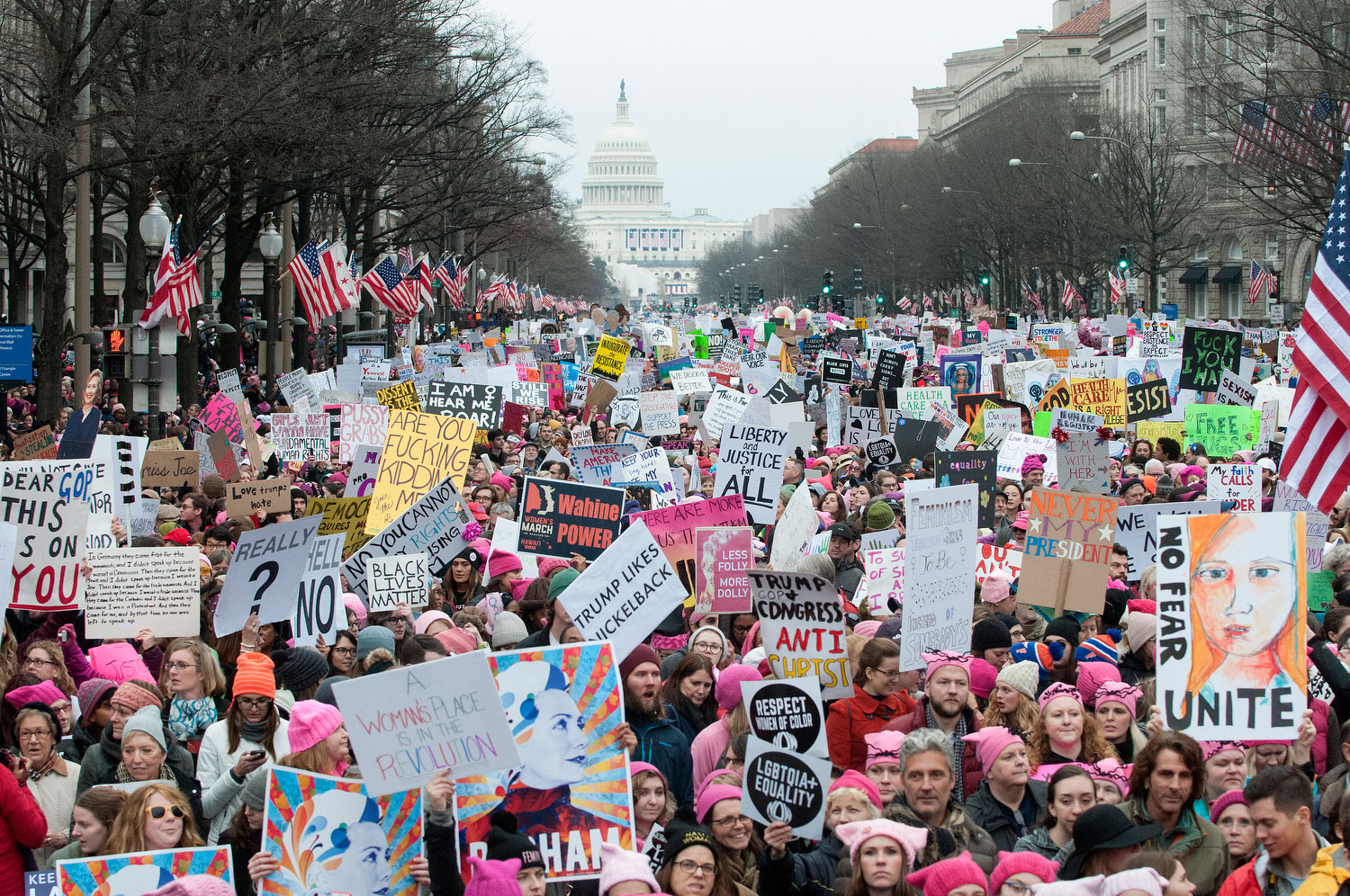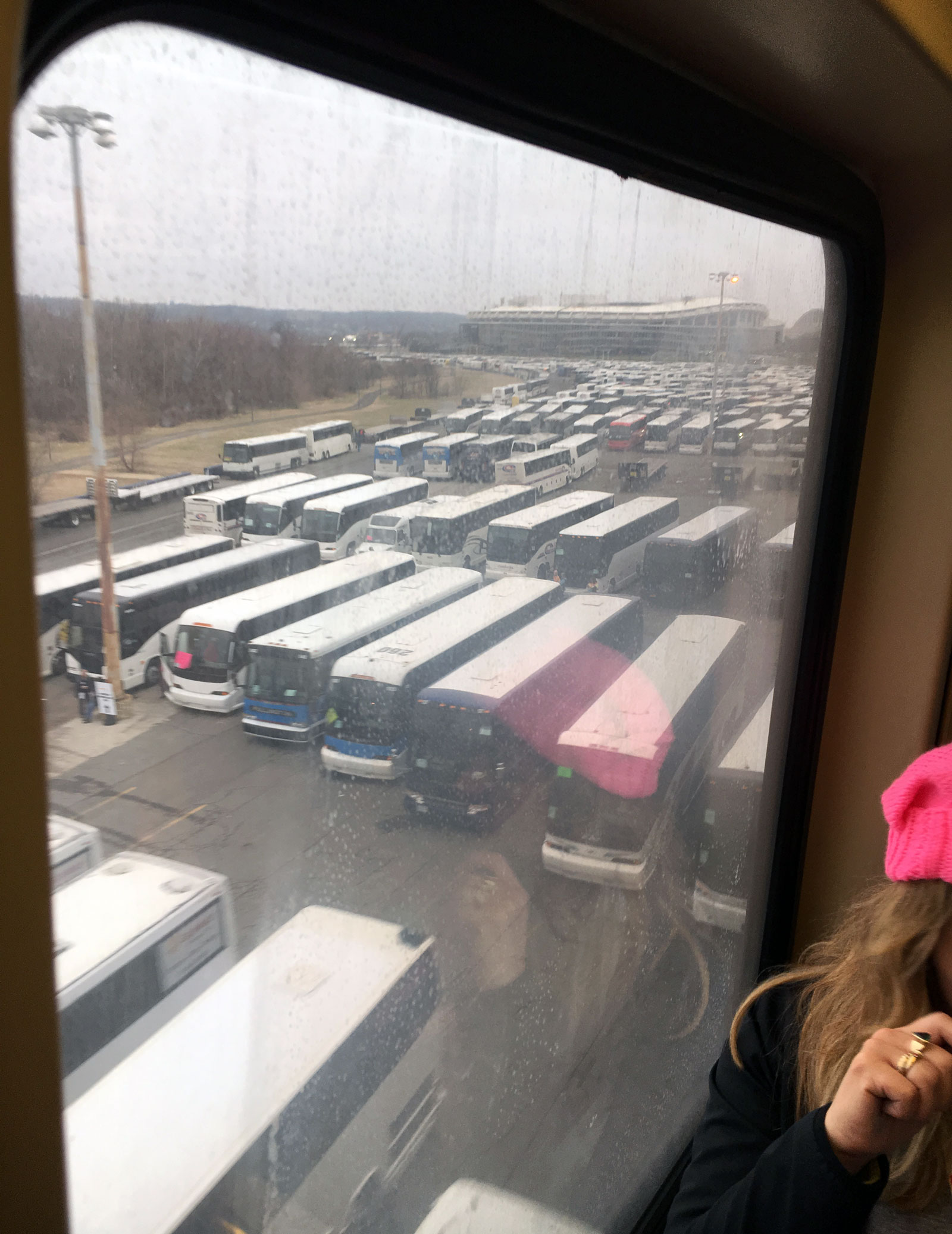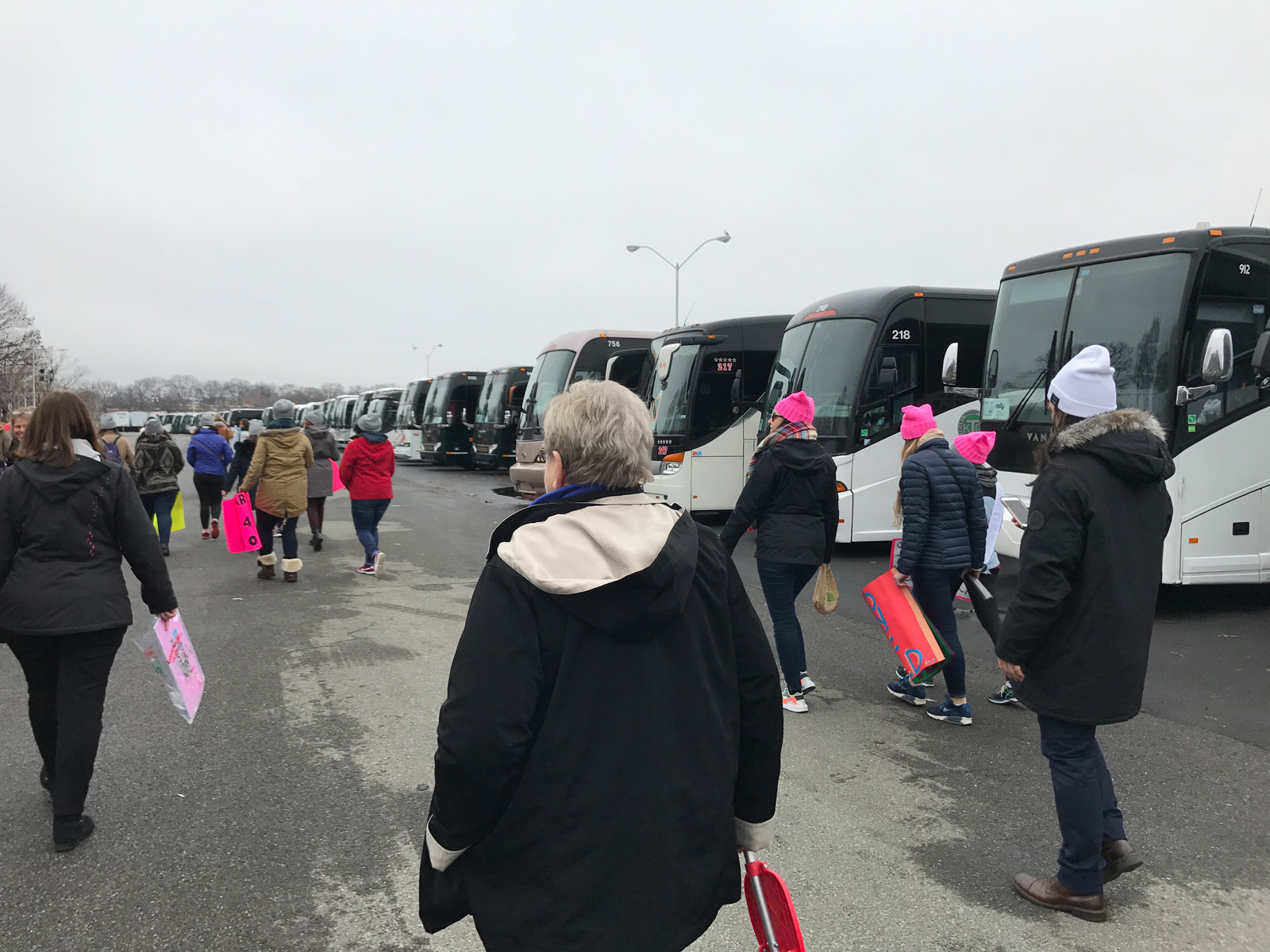The Women’s March on Washington began the way most grassroots ideas do these days: as a Facebook page. But for all the ways that social media has transformed political organizing—facilitating publicity and recruitment, and providing, for better or worse, a public forum for debate over membership, tactics, and goals—protest itself remains stubbornly analog, an activity of bodies assembled in a single place for a common purpose. So, too, the paraphernalia on which protest depends: buses and trains, poster board and markers, drinking water and Porta Potties, Band-Aids and walking shoes.
Of all this unheralded equipment, the bus stands out as protest’s defining symbol—the cheapest, most efficient means of transporting the greatest numbers of bodies over long distances since at least the Freedom Rides of the early 1960s. In this regard, the Women’s March was no different from the 1963 March on Washington, when buses streamed through the Baltimore Harbor Tunnel at a rate of one hundred per hour. On Saturday, we met our bus before dawn, on a street corner in the West Village, a couple dozen strangers clutching handmade signs, neck pillows, and clear plastic bags—march rules—filled with foil-wrapped sandwiches and water bottles. We made a stop uptown to pick up more passengers, including a pair of hitchhikers who’d overslept and missed their ride, fraternity being protest’s unspoken ethic.
By the time we hit the highway, all fifty-seven seats were occupied. We were a motley group: psychologists, lawyers, and teachers, parents and high-school students, a couple of bankers, a graphic designer, a composer, an artist, and an eight year old. Ten of us were men. A tupperware of homemade pumpkin bread made the rounds. Someone came down the aisle with chocolate-covered pretzels wrapped in little cellophane bags, each containing a slip of paper with an inspirational quote from Michelle Obama, Hillary Clinton, or Malala. Metro passes for the subway in D.C. were handed out. A protester travelling with an extra poster board and a Sharpie gave them to a protester who had neither. Someone Googled the Cyrillic for “Not my president.” (Не мой президент.) A cellphone was circulated, open to a photo of an aerial banner in the sky above Manhattan: WE OUTNUMBER HIM—RESIST.
In a sense, we were already marching. The fog hung thick over I-95 south, but as the sun rose, the highway outside our windows gradually became visible, and, so, too, the vehicles in the lanes alongside us: a preponderance of buses. Buses filled the service areas along the New Jersey Turnpike, the restrooms overflowing with their passengers: women and men in hand-knit pink “pussyhats”—a rebuke to Trump’s sexual crudity and a gleeful repurposing of a traditionally feminine domestic craft as a symbol of opposition. On the march’s app, where protesters posted images of themselves in demonstration regalia and cheered one another, one woman uploaded a photo of a needlepoint sampler she’d made. “I’M SO ANGRY I STITCHED THIS JUST SO I COULD STAB SOMETHING 3000 TIMES,” it read.
Arriving in late morning, at the parking lot near RFK Stadium, in D.C., two miles east of the Capitol, the sight of the more than a thousand other buses already there, was elating: irrefutable proof of our collective magnitude. (By the end of the day, lot attendants said, eighteen hundred buses had pulled in.) By the time our group ascended from the metro onto the mall, we had missed most of the pre-march rally. It hardly mattered. Few in the enormous throng of people already congregated there—we were packed in so tightly we could hardly move—could hear the speakers anyway. The mood was cheerful, almost giddy, as ebullient as Trump’s inaugural speech had been dark and glowering. As the crowd—women and men of all ages, some in wheelchairs, some walking with canes or pushing strollers—patiently inched its way along the march route, toward the grassy Ellipse in front of the White House, spontaneous chanting broke out in waves: “This is what democracy looks like!” “My Body, My Choice!” “We don’t want your tiny hands anywhere near our underpants!” And, my favorite, “We need a leader, not a creepy tweeter!” A handful of limber marchers perched in the branches of the trees lining the mall. A small, curly-haired boy and his mother held matching posters, hand-lettered in rainbow colors, spoofing lyrics from “Mary Poppins”: “Super Callous, Fascist, Racist, Extra Bragga Docious.” The D.C. police reported not a single march-related arrest. (According to The Washington Post, during the inauguration on Friday, more than 230 people were arrested for riotous behavior.)
Purely as a visual spectacle, the march was a rousing success: some 500,000 people assembled in the capital, as well millions more in other cities across the country and around the world. Together, these throngs of human faces—as diverse in their ethnic composition as the much smaller audience for Trump’s inauguration was overwhelmingly white—formed a single, incontestable rebuke. It was an expression of dissent directed at a president who is notoriously impatient with nuance—one marcher’s poster lamented, “All these signs, and Trump doesn’t read”—and who is fixated, to an alarming degree, on imagery, on the medium to the exclusion of the message; the protests spoke Trump’s language.
Advertisement
Obsessed with statistics and superlatives—the biggest, the greatest, the most—Trump can’t bear to be bested at his game. With the march underway outside the White House, his administration tried to change the subject to a different set of numbers: estimates of the turnout for his Inauguration the previous day. Meeting with reporters in the West Wing on Saturday afternoon, the White House press secretary, Sean Spicer, claimed that the crowd at the US Capitol on Friday had been “the largest audience to ever witness an inauguration,” and excoriated the media for publishing photographs indicating otherwise. (In fact, the turnout for Obama’s first inauguration was three times as large.) Trump was still focused on his inauguration numbers on Sunday morning, tweeting, “Wow, television ratings just out: 31 million people watched the Inauguration, 11 million more than the very good ratings from 4 years ago!” (In fact, the television audience for Obama’s first inauguration was considerably larger.) Trump’s counselor, Kellyanne Conway, went on television to defend the administration’s use of what she called “alternative facts,” christening its deceitful approach to reality with a risible new phrase that immediately began trending on Twitter. (As in: “Trump won the popular vote #alternativefacts.”)
But even the Trump administration couldn’t ignore the march, or deny its existence as so much fake news. When Trump finally addressed the protest that had taken place outside his front door, it was in a tweet that was mocking and dismissive, but that also grudgingly acknowledged, perhaps for the first time, the sheer number of Americans who oppose him: “Watched protests yesterday but was under impression that we just had an election! Why didn’t these people vote?” (Of course, most of us had, just not for him.)
Trump had seen us, and that was something. More important, we had stood with hundreds of thousands of other Americans determined to resist him. As Gloria Steinem told the crowd at the rally in Washington, “Sometimes we must put our bodies where our beliefs are. Sometimes, pressing send is not enough.” Looking ahead, the filmmaker Michael Moore urged the crowd to memorize the main number of the US Congress and to call it every day. On the bus ride back to the city that night, we vowed to heed his bidding, and to continue our activism however we could. One woman broke out a bottle of champagne. (She had planned to drink it on November 8, she said ruefully.) Once again, the roads and the rest stops along the northeast corridor were flooded with buses, the protest unfolding in reverse, as they ferried their passengers, exhausted but unbowed, home to bed.





